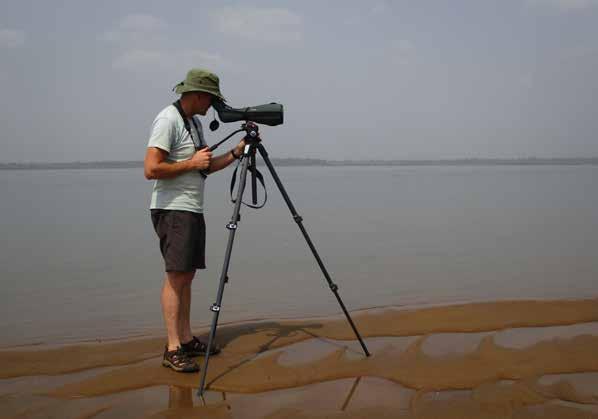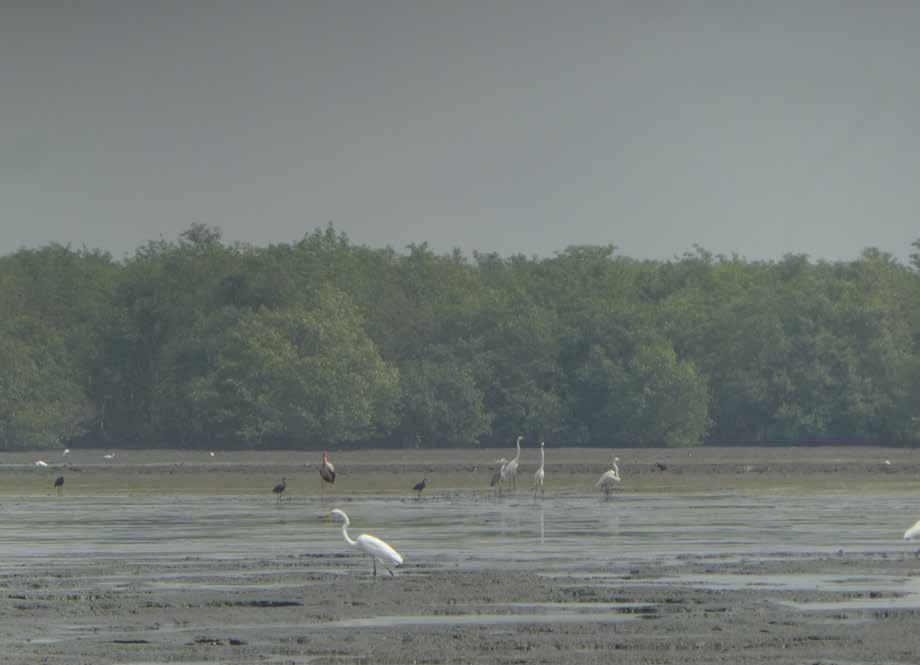
6 minute read
FROM THE EDITOR
Welcome...
...to the latest issue of WeBS News.
It has certainly been a challenging year for all of us with the ongoing Coronovirus pandemic impacting on our daily lives. Thankfully for WeBS reporting, the main lockdown period came in the spring rather than during our peak recording period, and so hopefully this won't have impacted on waterbird trends and peak counts too much. We thank you for your ongoing support.
Data received from WeBS counts are as important as ever, being widely used both by environmental consultants as part of environmental impact assessments, and also by government bodies for the designation and monitoring of protected sites (pg. 16).
The role of the Local Organiser (LO) is crucial to the running of WeBS, and we hear from the new LO on the Isle of Man about the challenges of recruiting new counters and covering sites that have been neglected for many years (pg. 12).
Neil Calbrade Editor & WeBS Officer
CONTINUED FROM COVER
comparison of results for stretches of coastline that are counted in different years. As was the case in 2014, the overall planning and additional financial support for the trip was provided by the Wadden Sea Flyway Initiative (WSFI), a project coordinated by Sovon (the Dutch Centre for Ornithology). The WSFI provides the umbrella for periodic coordinated censuses of waterbirds along the East Atlantic Flyway; in doing so, it provides important additional count data for the IWC.
Having arrived in the capital, Freetown, we first spent several days in the north of the country counting Scarcies Estuary and the Sierra Leone River Estuary (SLRE). Scarcies Estuary is a rural area, largely surrounded by farmland and small fishing villages, whereas the SLRE is adjacent to Freetown and several other large urban areas. Unsurprisingly, the human impacts such as mangrove cutting, sand mining and plastic pollution are far greater in SLRE, although waterbirds are still abundant on its largest mudflats.
We then moved south over the course of the next two weeks to cover Yawri Estuary, the Turtle Islands and most of the Sherbro Estuary. The southern estuaries of Sierra Leone are much less impacted than those further north, with extensive mangrove forest still present in many areas, and plastic pollution far less evident. These areas are mostly remote and hard to reach, with journeys by road taking many hours. All the fieldwork was boat-based and involved surveys of tidal mudflats, sandbanks, and mangrove creeks at low tide; operating as two teams to help maximise coverage of the estuaries during relatively constrained tidal
WeBS NEWS
WeBS NEWSLETTER CONTRIBUTORS
Gill Birtles WeBS Counter Network Organiser, BTO gill.birtles@bto.org Neil Calbrade WeBS Officer, BTO neil.calbrade@bto.org Allan Drewitt Senior Ornithologst, Natural England allan.drewitt@naturalengland.org.uk Teresa Frost WeBS National Organiser, BTO teresa.frost@bto.org Ros Green Research Ecologist, BTO ros.green@bto.org Richard Hearn Policy and Advocacy Manager (International), WWT richard.hearn@wwt.org.uk Chas Holt WeBS Counter and former National Organiser David Kennett WeBS Local Organiser Ruth Thomas WeBS Counter Brian Watmough WeBS Local Organiser
Photography Cover: Neil Calbrade, Brian Kelly and John Whitting. Inside: Guy Brrome, Peter Christian, Liz Cutting, Allan Drewitt, Edmund Fellowes, Chas Holt, Mark Mainwaring, Richard Poppe, Papanie Bai Sesay and John Whitting,.
NEWSLETTER PRODUCTION
Design Neil Calbrade Printing Swallowtail Print, Norwich
Thanks to Gill Birtles, Teresa Frost, Colette Hall, Sarah Harris and Anna Robinson for proofreading this newsletter.
The Wetland Bird Survey (WeBS) is the monitoring scheme for non-breeding waterbirds in the UK, which aims to provide the principal data for the conservation of their populations and wetland habitats. The data collected are used to assess the size of waterbird populations, assess trends in numbers and distribution and identify and monitor important sites for waterbirds. A programme of research underpins these objectives. Continuing a tradition begun in 1947, around 3,000 volunteer counters participate in synchronised monthly counts at wetlands of all habitat types, mainly during the winter period. The Wetland Bird Survey (WeBS) is a partnership jointly funded by BTO, RSPB and JNCC, in association with WWT with fieldwork conducted by volunteers.
BTO The Nunnery, Thetford, Norfolk IP24 2PU Tel: 01842 750050 www.bto.org RSPB The Lodge, Sandy, Bedfordshire SG19 2DL Tel: 01767 680551 www.rspb.org.uk
JNCC Monkstone House, City Road Peterborough PE1 1JY Tel: 01733 562626 www.jncc.gov.uk WWT Slimbridge, Gloucestershire GL2 7BT Tel: 01453 891900 www.wwt.org.uk
Information in this Newsletter is compiled from a variety of sources and does not necessarily reflect the views of WeBS partner organisations. © BTO 2020 Published by BTO/RSPB/JNCC.
When you have finished with this magazine, pass it to a friend or recycle it.
windows. Counts were undertaken at low tide, unlike in most coastal WeBS sectors, because at high tide most of the waders and other waterbirds roost in dense areas of mangrove where they are impossible to observe.
A trip to west Africa during the winter provides an opportunity to see a mix of exotic resident birds and migrants that are more familiar to birders from northwest Europe. Coastal wetlands in winter are dominated by waders that breed in the far north, many of which may migrate through WeBS sites during passage periods.
Over the course of the survey, the most abundant species proved to be Curlew Sandpiper with nearly 15,000 birds logged. Several thousand each of Whimbrel, Grey Plover, Redshank, Bar-tailed Godwit, Ringed Plover and Common Sandpiper were also counted, along with several hundred Knot, Greenshank, Sanderling and Avocet. Many of these counts exceed the relevant species thresholds for wetlands of international importance. These waders share the intertidal mudflats with a variety of other birds. A typical estuarine mudflat in Sierra Leone can feature Great White Egret, Grey Heron, Little Egret, Western Reef Egret, Green-backed Heron, Sacred Ibis, Woolly-necked Stork, Palm-nut Vulture and Pied Kingfisher, as well as, in favoured areas, more localised species such as Great White Pelican, Pink-backed Pelican, African Spoonbill and Black Egret. The sandbanks and spectacular Turtle Islands again held large groups of terns, comprising Royal (6,000), Sandwich (1,700), Common (1,300) and Little (1,100) with smaller numbers of Lesser Crested, Gull-billed, Caspian and Black Terns.
Away from mudflats and sandbanks, mangrove channels hold relatively low densities of birds but still provided encounters with a diverse range of species including several Hamerkops as well as a couple of Nile Crocodiles. Other memorable sightings during the surveys were provided by African Skimmer, Goliath Heron and Giant Kingfisher – all exceptional-looking birds! The most exciting discovery in terms of local rarity was a Laughing Gull, a first for Sierra Leone.
PAPANIE BAI SESAY (CSSL)/CHAS HOLT

Notable absentees from our list were Kentish Plover and Little Stint, whereas a census of the same area in 2005 produced totals of 98 Kentish Plover and 1,271 Little Stint! Populations of Kentish Plover are known to have declined across the species’ range and Little Stint are prone to marked fluctuations in annual breeding productivity on Arctic breeding grounds – but their apparent disappearances are striking.
As well as counting waterbirds, our activities in Sierra Leone included engagement with local communities and training of CSSL staff to help them develop their bird identification and counting skills. A preparatory training workshop also took place in December 2019 at Tasso Island Ecolodge, in the SLRE, where survey participants and other representatives of communities from all of the main Sierra Leonean estuaries learnt about waterbirds,

A selection of Herons, Egrets and a Stork feeding on the tidal mudflats are a familiar sight in Sierra Leone.
Counting waterbirds from sandbanks exposed by the low tide.
their ecology, monitoring and conservation, and the sustainable management of estuarine environments. Everyone involved in the initiative is keen for a regular and sustainable monitoring programme of surveys, undertaken by Sierra Leoneans, to become established. We therefore look forward to continuing this training in the future.
Sierra Leone is a poor, but beautiful, country which has suffered tough periods during its recent history, from militant warfare in the 1990s to an outbreak of Ebola in 2014 (incidentally a matter of weeks after our previous trip).
With the Coronovirus situation now affecting the health of communities around the world as well as impacting the ease of international travel, we hope that it is not too long before there is an opportunity to return and continue this important initiative.










